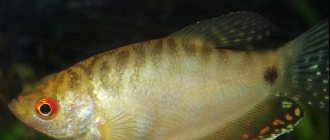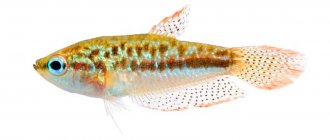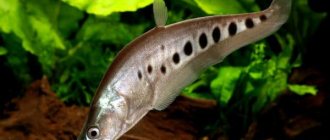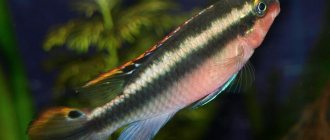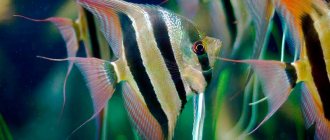Description
Gouramis process oxygen both from the aquatic environment and from the atmosphere. The homeland of honey coliza is the Ganges and Brahmaputra rivers. Habitat: Shallow areas with plenty of vegetation. The distinctive sign of all types of colises is two thread-like pelvic fins that perform tactile functions.
Benefits of content:
- Unpretentious to water quality.
- They eat any food.
- A size of up to 5 cm allows you to keep gourami in aquariums from 10 liters.
- Easy to care for.
Appearance
Externally, gourami are similar to their fellow lalius and striped colis. Main differences:
- Size no more than 5 cm. Males are smaller than females.
- The color of honeyfish ranges from yellow-brown to brick-red. The color is especially pronounced during the breeding season.
- Two fins, dorsal and anal. An inclined strip runs along the upper fin. Closer to the body, both parts of the plumage are colored in the main color of the fish. The upper part of the dorsal fin is bright neon yellow. The lower part of the anal process is darker, azure blue or black.
- The body is narrower in shape compared to other representatives of the genus Colis.
- A stripe of a darker color than the overall color runs down the middle of the body. In females this feature is more pronounced.
- The tactile fins are bright red or yellow.
- Females are much paler than males.
Behavior
Red gouramis have a peaceful nature. The fish get along well with other representatives of the aquarium fauna. Sometimes signs of aggressive behavior appear. This occurs during the breeding season or when there is a shortage of females.
Behavioral signs:
- Movement is slow.
- Shy character.
- They slowly adapt to a new environment and hide.
- They feel better in small flocks.
- They love various shelters.
Another interesting fact is associated with the spawning of honey gouramis. The breeding cycle is closely related to the onset of rainy seasons in India. Therefore, adding a significant portion of cool, soft water to the aquarium can cause unplanned reproduction of these fish.
Lifespan
The average lifespan of honey colyzes in captivity is 2 times longer than the lifespan of wild individuals. Several factors play a major role here:
- No predators or competition.
- There are no sudden changes in the microclimate.
- Good food.
Notes
Honey gourami is sold everywhere and is perfect for beginner aquarists, since the fish are peaceful in nature and adapt quite well to the conditions and composition of the water. Sold under different names.
As a result of selection, several variations have been created, including “red”, “sunset” and “golden” gouramis, their content is no different from the content of ordinary gouramis.
Yellow morph of Honey Gourami. Male on top, female on bottom. The female has a dark stripe along her body (MrReyno Tanks youtube.com)
Honey red gourami (MrReyno Tanks youtube.com)
Sources say that in the wild, gourami like to hunt insects that rest on leaves or branches near bodies of water, “spitting” droplets of water onto them.
Like other species in the order Labyrinthidae, Trichogaster chuna has a special labyrinthine organ responsible for the fish's respiration. Named so because of the organ’s external resemblance to a labyrinth, it allows the fish to breathe atmospheric oxygen at certain moments. The organ is a system of plates penetrated by blood vessels, which is located in the epibranchial cavity, and these plates function as one large respiratory surface during breathing. The structure of the organ varies depending on the species and is more developed in those fish that live in harsher conditions.
—— en.wikipedia.org/wiki/Honey_gourami www.seriouslyfish.com/species/trichogaster-chuna/animal-world.com/encyclo/fresh/anabantoids/flamegour.php www.fishbase.org/summary/11201
Content
Proper conditions for keeping honey gouramis are the key to the health and longevity of your pets. Despite the unpretentious nature of honey colises, you need to know some features of breeding these representatives of the aquarium fauna:
- Aquarium capacity from 10 liters for 2 individuals. More is better.
- Access to air is required.
- The optimal water temperature is 23–25 degrees.
- Floating plants in the water column and covering part of the surface.
- The presence of snags and shelters.
- Honey gouramis are prone to obesity.
- It is better to keep fish in a small school of 4–8 individuals of both sexes.
Aquarium
The natural habitat of honey colises itself dictates the volume and shape of the aquarium. Containers in which the width is greater than the depth (height) are better suited for keeping individuals of this species.
Basic parameters of the aquarium:
- Volume based on 10–12 liters per pair.
- The width should be greater than the depth.
- The presence of a lid is necessary to maintain the internal microclimate, since honey gouramis need oxygen from the atmosphere.
- The need for compressors depends on the number of plants.
Water parameters
The fish are unpretentious to water quality; their main habitat is muddy, shallow places.
Main requirements:
- Temperature 22–27 degrees C. Fish are very sensitive to temperature changes.
- Softness 5–15%.
- pH value ranges from 5.9–7.4.
- Change water every 5–7 days by at least 1/5 of the total volume of the aquarium.
Plants
The presence of a large amount of vegetation in the water is the native habitat for honey golden gouramis. This species does not like bright direct light. Plants with long stems and leaves covering the surface of the water have several positive effects:
- Create diffused lighting in the aquarium.
- Provide additional shelter for fish.
- They maintain the desired microclimate above the surface of an artificial reservoir.
The main requirement for plants is the tolerance of warm water. To maintain colises of all types, purchase:
- Vallisneria.
- Watercolor.
- Elodea.
- Salvinia.
- Cirrus.
- Riccia.
- Pistia.
- Limnophila.
Priming
It is recommended to choose soils of dark tones; such shades of the bottom cause more active pigmentation in honey colises. The fish are becoming brighter.
Soil requirements:
- Dark or black color.
- Small faction.
- Presence of humus secretions.
Gourami behavior and compatibility
Tank mates should be selected carefully, as this species moves slowly, is easily spooked, and can become easy prey for larger fish.
Peaceful carp, which prefer the thickness or surface of the aquarium, are a good option, as are not particularly active loaches (Pangio spp.), some species from the genus Nemacheilus. Species that fight for territory or are otherwise aggressive are not allowed.
Although the Honey Gourami does not gather in large schools, it feels best and is active when interacting with several individuals at once, so it is recommended to purchase at least 4-6 fish. A noticeable hierarchy is formed in groups, so you can watch how the leaders chase their rivals, driving them away from food during feeding, or take their favorite places in the aquarium.
Feeding
In their natural habitat, honey colyses feed on small insects and their larvae. By nature, this type of fish is omnivorous.
Suitable for feeding:
- Live feed compositions.
- Dry mixes.
- Special cereals.
- Frozen food.
Feeding frequency is once every 12–24 hours. One should remember about the tendency towards obesity in these representatives of the genus Coliseum. Excess food will lead to illness and death of the fish.
How to get offspring
Honey gouramis are ready to breed at the age of 6-8 months. This process is simple. It can occur in a community aquarium, which is beneficial for the females as they will not become sour, but in this case it is difficult to preserve the fry.
To increase their chances of survival, it is recommended to carefully scoop the nest with a saucer and transfer it to another container. The courting male needs to be transplanted there.
Organization of spawning grounds. The option with a spawning tank is still preferable.
- A 10-liter container is suitable for a couple, and a 40-liter container with a lid is suitable for a group.
- Water is poured no higher than a level of 15-20 cm. It should have a temperature of 26-29 °C, a hardness of no more than 5 °dH and an acidity of 6.0-6.5 pH.
- Plants with wide leaves such as nymphs are placed there.
- Soil is optional.
- Sometimes it is recommended to close the front glass so as not to disturb the fish.
Spawning occurs in pairs or small groups. Males are tolerant of females. The fish selected for breeding are fed plentifully and nutritiously. As soon as the female gets fat from the eggs, the male is sent to the spawning ground to build a nest of foam under the leaf of a large plant, and she is launched as soon as the “lullaby” is ready.
After completion of construction, the male lures the “lady” to him, after which spawning begins. It looks like a typical labyrinth embrace - the male wraps himself around the frozen female and squeezes eggs out of her, which he immediately fertilizes. This is repeated several times. The quantity of caviar can reach 300 pieces.
After the end of spawning, the female is removed. The male is set aside until the eggs hatch, that is, for about 1-1.5 days, and then they are also removed.
Caring for offspring. The water in the spawning tank is reduced to a level of no more than 10 cm, heated to 30 degrees and gentle aeration is turned on. It will be possible to add water and remove the aerator only after the fry have formed a labyrinthine organ (they will begin to rise to the surface and gasp for air).
After 3 days, as soon as the fry swim, they are fed with ciliates and mashed egg yolk several times a day, avoiding starvation. After 10-14 days they are transferred to Artemia nauplii. As they grow older, they need sorting, as gouramis have a tendency to cannibalism.
Reproduction
The fish reproduce well in aquarium conditions. Within the microflock, over time, its own hierarchy and pairs are formed. Honey-red gourami is a species that forms temporary pairs during the spawning period. A distinctive feature of the resulting pair is their continuous swimming together.
Sex differences
Females are larger than males and have a paler color. The ends of the fins have a rounded shape.
The male is smaller in size and brighter in color. The ends of the fins are sharp. During the breeding season, the color changes:
- The overall color brightness of the color increases.
- The stripe running along the body becomes almost invisible.
- The lower fin and head become dark blue and black.
Spawning
For spawning, it is better to deposit the resulting pairs in a separate container. For such a container you will need:
- Aquarium from 10 liters for one couple.
- The water level in the container is 20–25 cm.
- The presence of broad-leaved plants is mandatory.
Spreading
The honey gourami is native to India and South Asia. The fish live in freshwater bodies of water with weak currents and low water levels. Representatives of this species can sometimes be found in flooded rice fields. One of the most famous habitats of honey gouramis is the Brahmaputra and Gana rivers, where a large number of labyrinth fish live.
Diseases
The main reasons for the appearance of diseases in an aquarium are the introduction of new, already infected inhabitants. Among the most common ones are:
- Velvet disease (oodiniosis) is a skin disease caused by parasitic organisms.
- Fungal disease of the oral organs - the lips of fish are puffed up and stretched out as if for a kiss. The cause is fungi imported from tropical waters.
Maintaining a clean and healthy atmosphere inside the aquarium is the key to the health of its inhabitants. Each newly acquired fish must be kept in quarantine for 20–30 days.
Habitat
Distributed mainly in the Far East, they inhabit rivers and lakes, ponds, ditches, and flooded fields. Many of these areas experience seasonal fluctuations due to the annual monsoon from June to October. Fish prefer areas with dense vegetation, weak currents or standing water. They feed on small invertebrates, insects and other zooplankton. During feeding, interesting behavior is observed: Gourami catches its prey, which may even be above the water. Having caught up with the victim, the fish, with a sharp contraction of its mouth, releases a stream of water, disposing of the insect from a branch, leaf, or during flight.
Reviews
Reviews from honey gourami owners are only positive. If healthy fish are purchased and the conditions of detention are observed, they will bring only positive emotions to their owners.
Photo gallery
Adviсe
- Try to purchase only healthy specimens.
- To avoid losing your pets, be sure to follow the compatibility guidelines.
- Honey gouramis look very impressive on soils with dark shades.
- Don't overfeed your fish.
- Change about 25-30% of the water at least once a week.
- Keeping them in pairs or in small schools has a good effect on the well-being and behavior of these fish.
- You should not get carried away with too bright light design of the aquarium. Otherwise, the gourami will constantly hide among the plants.
- The fish are very shy, so it is necessary to have various hiding places.
Previous
FishGoldfish Care Guide
Next
FishFish from breeders - yellow molly
Sex differences
It is easy to distinguish a male from a female. The sexually mature male is brighter in coloration, showing bright orange coloring around the throat area, which becomes much brighter during breeding and is used to court the female. The undersides of males turn black when breeding. Males also exhibit an orange tint on their fins, with the exception of the caudal fin. The male also has longer fins, with a pointed dorsal fin and elongated anal fin rays.
The female is larger than the male, the color is more faded. In addition, the couple usually swims together.

